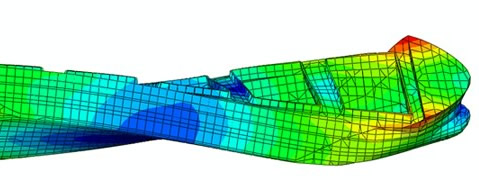
The excitations induced by the propulsion system are the main source of the ship vibrations. These excitations from the propulsion system can be seen in can occur in several ways. Dynamic forces such as thrust and moment variations from the propeller are transmitted to the hull through shaft bearings. The propeller induced fluctuating pressures on the hull surface induces vibration on the ship structure. The main and auxiliary engines can excite the ship's natural frequencies through dynamic forces transmitted from the foundations and supports. These excitations can cause the vibration of the hull girder, deckhouses, local structures and equipment. The order of the excitation frequencies from the propulsion system can be shaft rotational frequency (RPM), blade frequency and their harmonics. The main engine induced unbalanced excitations for the slow speed diesel engines are the first and second order external forces and moments.
The response of the hull structure may be resonant or non-resonant.